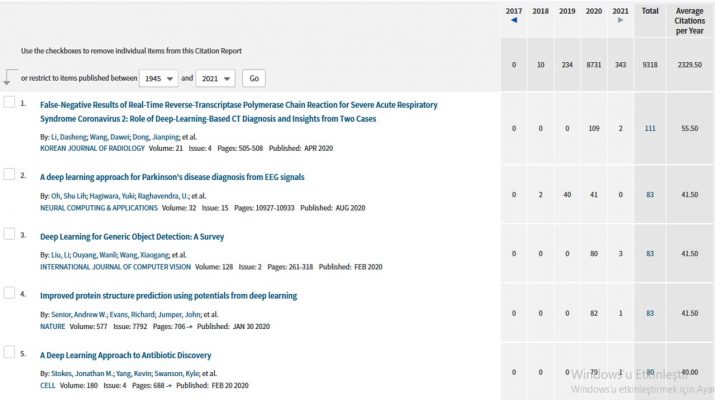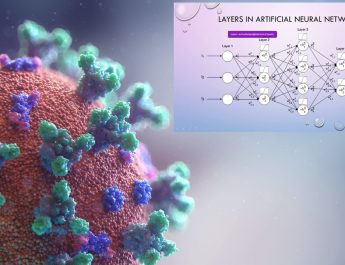The most highly-cited articles published in Web of Science Database in 2020 related to “Deep Learning” are below.
By: Li, Dasheng; Wang, Dawei; Dong, Jianping; et al.
KOREAN JOURNAL OF RADIOLOGY Volume: 21 Issue: 4 Pages: 505-508 Published: APR 2020
The epidemic of 2019 novel coronavirus, later named as severe acute respiratory syndrome coronavirus 2 (SARS-CoV-2), is still gradually spreading worldwide. The nucleic acid test or genetic sequencing serves as the gold standard method for confirmation of infection, yet several recent studies have reported false-negative results of real-time reverse-transcriptase polymerase chain reaction (rRT-PCR). Here, we report two representative false-negative cases and discuss the supplementary role of clinical data with rRT-PCR, including laboratory examination results and computed tomography features. Coinfection with SARS-COV-2 and other viruses has been discussed as well.
2. A deep learning approach for Parkinson’s disease diagnosis from EEG signals
By: Oh, Shu Lih; Hagiwara, Yuki; Raghavendra, U.; et al.
NEURAL COMPUTING & APPLICATIONS Volume: 32 Issue: 15 Pages: 10927-10933 Published: AUG 2020
An automated detection system for Parkinson’s disease (PD) employing the convolutional neural network (CNN) is proposed in this study. PD is characterized by the gradual degradation of motor function in the brain. Since it is related to the brain abnormality, electroencephalogram (EEG) signals are usually considered for the early diagnosis. In this work, we have used the EEG signals of twenty PD andtwentynormal subjects in this study. Athirteen-layer CNN architecture which can overcome the need for the conventional feature representation stages is implemented. The developed model has achieved a promising performance of 88.25% accuracy, 84.71% sensitivity, and 91.77% specificity. The developed classification model is ready to be used on large population before installation of clinical usage.
3. Deep Learning for Generic Object Detection: A Survey
By: Liu, Li; Ouyang, Wanli; Wang, Xiaogang; et al.
INTERNATIONAL JOURNAL OF COMPUTER VISION Volume: 128 Issue: 2 Pages: 261-318 Published: FEB 2020
Object detection, one of the most fundamental and challenging problems in computer vision, seeks to locate object instances from a large number of predefined categories in natural images. Deep learning techniques have emerged as a powerful strategy for learning feature representations directly from data and have led to remarkable breakthroughs in the field of generic object detection. Given this period of rapid evolution, the goal of this paper is to provide a comprehensive survey of the recent achievements in this field brought about by deep learning techniques. More than 300 research contributions are included in this survey, covering many aspects of generic object detection: detection frameworks, object feature representation, object proposal generation, context modeling, training strategies, and evaluation metrics. We finish the survey by identifying promising directions for future research.
4. Improved protein structure prediction using potentials from deep learning
By: Senior, Andrew W.; Evans, Richard; Jumper, John; et al.
NATURE Volume: 577 Issue: 7792 Pages: 706-+ Published: JAN 30 2020
Protein structure prediction can be used to determine the three-dimensional shape of a protein from its amino acid sequence. This problem is of fundamental importance as the structure of a protein largely determines its function; however, protein structures can be difficult to determine experimentally. Considerable progress has recently been made by leveraging genetic information. It is possible to infer which amino acid residues are in contact by analysing covariation in homologous sequences, which aids in the prediction of protein structures. Here we show that we can train a neural network to make accurate predictions of the distances between pairs of residues, which convey more information about the structure than contact predictions. Using this information, we construct a potential of mean force that can accurately describe the shape of a protein. We find that the resulting potential can be optimized by a simple gradient descent algorithm to generate structures without complex sampling procedures. The resulting system, named AlphaFold, achieves high accuracy, even for sequences with fewer homologous sequences. In the recent Critical Assessment of Protein Structure Prediction (CASP13)-a blind assessment of the state of the field-AlphaFold created high-accuracy structures (with template modelling (TM) scores of 0.7 or higher) for 24 out of 43 free modelling domains, whereas the next best method, which used sampling and contact information, achieved such accuracy for only 14 out of 43 domains. AlphaFold represents a considerable advance in protein-structure prediction. We expect this increased accuracy to enable insights into the function and malfunction of proteins, especially in cases for which no structures for homologous proteins have been experimentally determined.
5. A Deep Learning Approach to Antibiotic Discovery
By: Stokes, Jonathan M.; Yang, Kevin; Swanson, Kyle; et al.
CELL Volume: 180 Issue: 4 Pages: 688-+ Published: FEB 20 2020
Due to the rapid emergence of antibiotic-resistant bacteria, there is a growing need to discover new antibiotics. To address this challenge, we trained a deep neural network capable of predicting molecules with antibacterial activity. We performed predictions on multiple chemical libraries and discovered a molecule from the Drug Repurposing Hub-halicin-that is structurally divergent from conventional antibiotics and displays bactericidal activity against a wide phylogenetic spectrum of pathogens including Mycobacterium tuberculosis and carbapenem-resistant Enterobacteriaceae. Halicin also effectively treated Clostridioides difficile and pan-resistant Acinetobacter baumannii infections in murine models. Additionally, from a discrete set of 23 empirically tested predictions from >107 million molecules curated from the ZINC15 database, our model identified eight antibacterial compounds that are structurally distant from known antibiotics. This work highlights the utility of deep learning approaches to expand our antibiotic arsenal through the discovery of structurally distinct antibacterial molecules.
6. Fast Beamforming Design via Deep Learning
By: Huang, Hao; Peng, Yang; Yang, Jie; et al.
IEEE TRANSACTIONS ON VEHICULAR TECHNOLOGY Volume: 69 Issue: 1 Pages: 1065-1069 Published: JAN 2020
Beamforming is considered as one of the most important techniques for designing advanced multiple-input and multiple-output (MIMO) systems. Among existing design criterions, sum rate maximization (SRM) under a total power constraint is a challenge due to its nonconvexity. Existing techniques for the SRM problem only obtain local optimal solutions but require huge amount of computation due to their complex matrix operations and iterations. Unlike these conventional methods, we propose a deep learning based fast beamforming design method without complex operations and iterations. Specifically, we first derive a heuristic solution structure of the downlink beamforming through the virtual equivalent uplink channel based on optimum MMSE receiver which separates the problem into power allocation and virtual uplink beamforming (VUB) design. Next, beamforming prediction network (BPNet) is designed to perform the joint optimization of power allocation and VUB design. Moreover, the BPNet is trained offline using two-step training strategy. Simulation results demonstrate that our proposed method is fast while obtains the comparable performance to the state-of-the-art method.
7. Deep learning fault diagnosis method based on global optimization GAN for unbalanced data
By: Zhou, Funa; Yang, Shuai; Fujita, Hamido; et al.
KNOWLEDGE-BASED SYSTEMS Volume: 187 Article Number: 104837 Published: JAN 2020
Deep learning can be applied to the field of fault diagnosis for its powerful feature representation capabilities. When a certain class fault samples available are very limited, it is inevitably to be unbalanced. The fault feature extracted from unbalanced data via deep learning is inaccurate, which can lead to high misclassification rate. To solve this problem, new generator and discriminator of Generative Adversarial Network (GAN) are designed in this paper to generate more discriminant fault samples using a scheme of global optimization. The generator is designed to generate those fault feature extracted from a few fault samples via Auto Encoder (AE) instead of fault data sample. The training of the generator is guided by fault feature and fault diagnosis error instead of the statistical coincidence of traditional GAN. The discriminator is designed to filter the unqualified generated samples in the sense that qualified samples are helpful for more accurate fault diagnosis. The experimental results of rolling bearings verify the effectiveness of the proposed algorithm.
By: Wang, Yalin; Pan, Zhuofu; Yuan, Xiaofeng; et al.
ISA TRANSACTIONS Volume: 96 Pages: 457-467 Published: JAN 2020
Deep learning networks have been recently utilized for fault detection and diagnosis (FDD) due to its effectiveness in handling industrial process data, which are often with high nonlinearities and strong correlations. However, the valuable information in the raw data may be filtered with the layer-wise feature compression in traditional deep networks. This cannot benefit for the subsequent fine-tuning phase of fault classification. To alleviate this problem, an extended deep belief network (EDBN) is proposed to fully exploit useful information in the raw data, in which raw data is combined with the hidden features as inputs to each extended restricted Boltzmann machine (ERBM) during the pre-training phase. Then, a dynamic EDBN-based fault classifier is constructed to take the dynamic characteristics of process data into consideration. Finally, to test the performance of the proposed method, it is applied to the Tennessee Eastman (TE) process for fault classification. By comparing EDBN and DBN under different network structures, the results show that EDBN has better feature extraction and fault classification performance than traditional DBN.
By: Liu, Bin; Li, Chen-Chen; Yan, Ke
BRIEFINGS IN BIOINFORMATICS Volume: 21 Issue: 5 Pages: 1733-1741 Published: SEP 2020
Protein fold recognition is critical for studying the structures and functions of proteins. The existing protein fold recognition approaches failed to efficiently calculate the pairwise sequence similarity scores of the proteins in the same fold sharing low sequence similarities. Furthermore, the existing feature vectorization strategies are not able to measure the global relationships among proteins from different protein folds. In this article, we proposed a new computational predictor called DeepSVM-fold for protein fold recognition by introducing a new feature vector based on the pairwise sequence similarity scores calculated from the fold-specific features extracted by deep learning networks. The feature vectors are then fed into a support vector machine to construct the predictor. Experimental results on the benchmark dataset (LE) show that DeepSVM-fold obviously outperforms all the other competing methods.
10. Deep Learning for Physical-Layer 5G Wireless Techniques: Opportunities, Challenges and Solutions
By: Huang, Hongji; Guo, Song; Gui, Guan; et al.
IEEE WIRELESS COMMUNICATIONS Volume: 27 Issue: 1 Pages: 214-222 Published: FEB 2020
The new demands for high-reliability and ultra-high capacity wireless communication have led to extensive research into 5G communications. However, current communication systems, which were designed on the basis of conventional communication theories, significantly restrict further performance improvements and lead to severe limitations. Recently, the emerging deep learning techniques have been recognized as a promising tool for handling the complicated communication systems, and their potential for optimizing wireless communications has been demonstrated. In this article, we first review the development of deep learning solutions for 5G communication, and then propose efficient schemes for deep learning-based 5G scenarios. Specifically, the key ideas for several important deep learning-based communication methods are presented along with the research opportunities and challenges. In particular, novel communication frameworks of NOMA, massive multiple-input multiple-output (MIMO), and millimeter wave (mmWave) are investigated, and their superior performances are demonstrated. We envision that the appealing deep learning- based wireless physical layer frameworks will bring a new direction in communication theories and that this work will move us forward along this road.
Source: Web of Science




